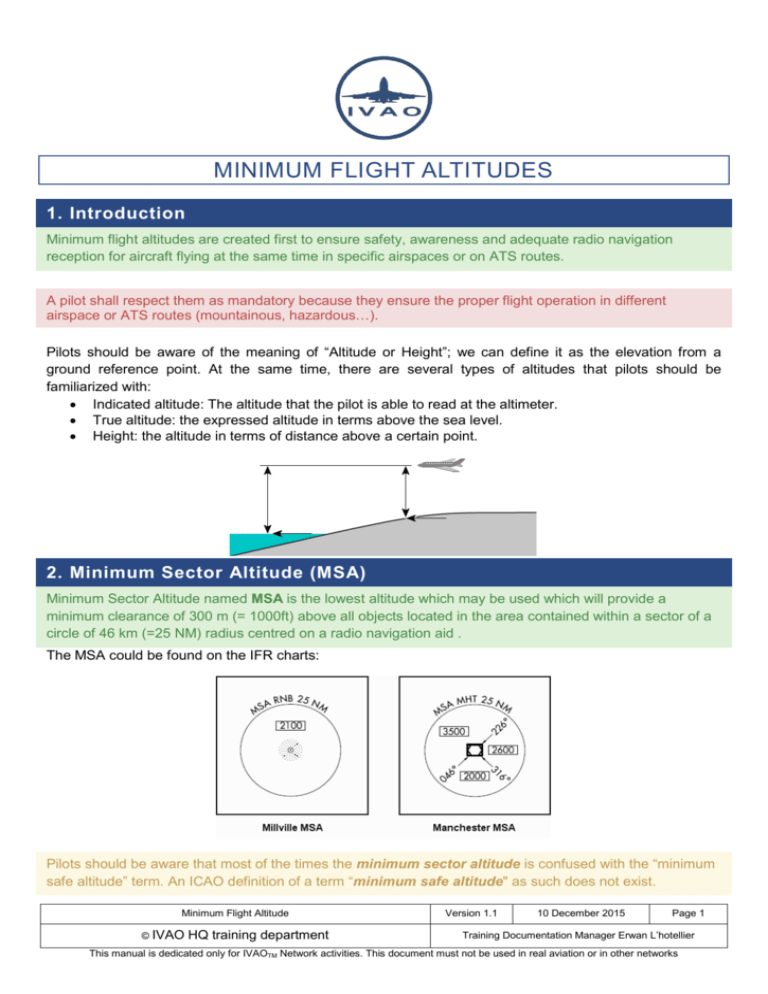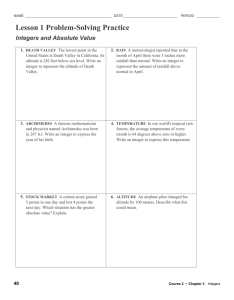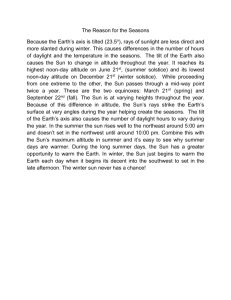Minimum Flight Altitudes: A Pilot's Guide
advertisement

MINIMUM FLIGHT ALTITUDES 1. Introduction Minimum flight altitudes are created first to ensure safety, awareness and adequate radio navigation reception for aircraft flying at the same time in specific airspaces or on ATS routes. A pilot shall respect them as mandatory because they ensure the proper flight operation in different airspace or ATS routes (mountainous, hazardous…). Pilots should be aware of the meaning of “Altitude or Height”; we can define it as the elevation from a ground reference point. At the same time, there are several types of altitudes that pilots should be familiarized with: Indicated altitude: The altitude that the pilot is able to read at the altimeter. True altitude: the expressed altitude in terms above the sea level. Height: the altitude in terms of distance above a certain point. 2. Minimum Sector Altitude (MSA) Minimum Sector Altitude named MSA is the lowest altitude which may be used which will provide a minimum clearance of 300 m (= 1000ft) above all objects located in the area contained within a sector of a circle of 46 km (=25 NM) radius centred on a radio navigation aid . The MSA could be found on the IFR charts: Pilots should be aware that most of the times the minimum sector altitude is confused with the “minimum safe altitude” term. An ICAO definition of a term “minimum safe altitude" as such does not exist. Minimum Flight Altitude © IVAO HQ training department Version 1.1 10 December 2015 Page 1 Training Documentation Manager Erwan L’hotellier This manual is dedicated only for IVAOTM Network activities. This document must not be used in real aviation or in other networks 3. Minimum En-route Altitude (MEA) Minimum En-route Altitude named MEA is the altitude for an en-route segment that provides adequate reception of relevant navigation facilities and ATS communications complies with the airspace structure and provides the required obstacle clearance. Pilots should know that MEA will assure: proper reception of navigation aids two-way communication with ATC safe clearance or margin from obstacles adherence to ATC or local procedures MEA for V32 airway = 11000ft. MEA for V6 airway = 12000ft. Minimum Flight Altitude © IVAO HQ training department Version 1.1 10 December 2015 Page 2 Training Documentation Manager Erwan L’hotellier This manual is dedicated only for IVAOTM Network activities. This document must not be used in real aviation or in other networks 4. Minimum Obstacle Clearance Altitude (MOCA) Minimum Obstacle Clearance Altitude named MOCA is the minimum altitude for a defined segment that provides the required obstacle clearance. The MOCA is determined and published for each segment of the route. Charts will provide the proper horizontal and vertical separation at those areas where the existence of obstacles could be a factor for the safety of flights. The MOCA will specify minimum vertical separation of 1000ft (300m) from the ground or landmarks. The MOCA may put an aircraft below ATC radar coverage (MRVA) and/or below the minimum reception altitude (MRA). Pilots flying in the USA should know that the MOCA assures also 22NM VOR reception range At the same time, certain aspects could affect this value, factors like terrain or mountainous areas could change this value according to the following circumstances. The MOCA will specify minimum vertical separation: 1000ft (300m) separation when the obstacle elevations is below 3000ft (900m) 1500ft (450m) separation when the obstacle elevations is between 3000ft (900m) to 5000ft (1500m). 2000ft (600m) separation when the obstacle elevations is greater than 5000ft (1500m or more). The MOCA is always related with one MEA. MEA and MOCA relation Minimum Flight Altitude © IVAO HQ training department Version 1.1 10 December 2015 Page 3 Training Documentation Manager Erwan L’hotellier This manual is dedicated only for IVAOTM Network activities. This document must not be used in real aviation or in other networks 5. Minimum off route altitudes (MORA) The pilot should be aware of the existence of two variations in this category: the MORA and the GRID MORA. The minimum off route altitude named MORA is an altitude which provides 2,000 feet of terrain clearance in mountainous areas and 1,000 feet in non-mountainous regions; at the same time it provides a reference point of clearance of 10 nm from the route centreline. The GRID MORA provides terrain and man-made structure clearance within the section outlined by latitude and longitude lines. The Grid MORA value clears all terrain and man-made structures by 1000ft in areas where the highest elevations are 5000ft MSL or lower and by 2000ft in areas where the highest elevations are 5001ft MSL or higher. The Grid MORA is a good value to determinate obstacle clearance whenever the pilot has to, or would like to divert from the airway, e.g. during an emergency descent or when flying direct to a point away from an airway. They are presented in hundreds of feet (feet with omitting the last two digits; example: 7,600 feet is given as 76). 6 4 GRID MORA examples: 8 (=8600ft) & 9 (=9400ft). Minimum Flight Altitude © IVAO HQ training department Version 1.1 10 December 2015 Page 4 Training Documentation Manager Erwan L’hotellier This manual is dedicated only for IVAOTM Network activities. This document must not be used in real aviation or in other networks GRID MORA versus MEA 6. Minimum Crossing Altitude (MCA) The Minimum Crossing Altitude named MCA is the lowest altitude at which a navigational fix can be crossed when entering or continuing along an airway that will allow an aircraft to clear all obstacles while carrying out a normal climb to the required minimum en route IFR altitude (MEA) of the airway in question beyond the fix The MCA is related with signal reception and obstacle clearance; this will be indicated by a flagged [X] on NOS and Jeppesen charts as an airway number and altitude. The pilot should climb to the MCA before reaching the intersection; in that way the MCA will not be violated. Example: A552 12000S means route A552 should be flown at 12000 when heading south. MCA JESSY 13000N (flagged X) = minimum 13000ft heading NORTH at JESSY Minimum Flight Altitude © IVAO HQ training department Version 1.1 10 December 2015 Page 5 Training Documentation Manager Erwan L’hotellier This manual is dedicated only for IVAOTM Network activities. This document must not be used in real aviation or in other networks 7. Minimum Reception Altitude (MRA) The Minimum Reception Altitude named MRA is the lowest altitude on an airway segment where an aircraft can be assured of receiving signals from navigation aids like VOR or NDB. Typically, the greater the distance between navigation aids, the higher is the MRA. On NOS charts it is described with a flagged R. On Jeppesen charts it will say the altitude plus MRA. MRA at CITOP =11200 feet. MRA is becoming less important with the availability of GPS satellite navigation, which allows aircraft to get navigational guidance all the way down to the ground. Minimum Flight Altitude © IVAO HQ training department Version 1.1 10 December 2015 Page 6 Training Documentation Manager Erwan L’hotellier This manual is dedicated only for IVAOTM Network activities. This document must not be used in real aviation or in other networks 8. Minimum Vectoring Altitude (MVA or MRVA or ASMA) The Minimum Vectoring Altitude named MVA is the lowest altitude, expressed in feet AMSL, to which a radar controller may issue aircraft altitude clearances during vectoring/direct routing except if otherwise authorized for radar approaches, departures and missed approaches. In some sources this altitude is also referred to as Minimum Flight Altitude (MFA), Minimum Radar Vectoring Altitude (MRVA) or ATC Surveillance Minimum Altitude (ASMA). The minimum vectoring altitude in each sector provides 1000ft above the highest obstruction in nonmountainous areas and 2000ft above the highest obstacle in designated mountainous areas. MVA description chart. Minimum Flight Altitude © IVAO HQ training department Version 1.1 10 December 2015 Page 7 Training Documentation Manager Erwan L’hotellier This manual is dedicated only for IVAOTM Network activities. This document must not be used in real aviation or in other networks 9. Minimum Holding Altitude (MHA) The Minimum Holding Altitude named MHA is the lowest altitude prescribed for a holding pattern that assures navigational signal coverage, communications, and meets obstacle clearance requirements. Pilots should be aware of the MHA when entering or starting a holding procedure at all times in order to meet the safety requirements. MHA description Minimum Flight Altitude © IVAO HQ training department Version 1.1 10 December 2015 Page 8 Training Documentation Manager Erwan L’hotellier This manual is dedicated only for IVAOTM Network activities. This document must not be used in real aviation or in other networks







